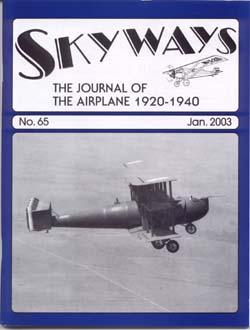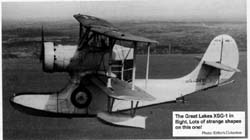 Skyways Skyways
The Journal Of The Airplane 1920-1940
No. 65, January 2003
The big, ugly, Witteman-Lewis XNBL-1 ("Barling Bomber" after its designer Walter Barling) on the cover leads us into this quarter's main feature article... BARLING TO B-36; HEMISPHERIC DEFENSE AND THE VLR (Very Long Range) BOMBER CONCEPT by E. R. Johnson. The analysis starts with the Barling Bomber of 1921 and ends with the Northrop B-2 of 1989. An article such as this demonstrates one of the difficulties an historical publication has in trying to define its scope within brackets of arbitrarily chosen dates (1920-1940) because history does not happen in neatly packaged episodes but rather in confusingly overlapping tableaus with, usually, somewhat indistinct beginnings and endings - unlike novels. That said, the article very well covers this nearly 70 year period of strategic bombardment. Another feature, THE GREAT LAKES STORY, sets out the history and product line of the Great Lakes Aircraft Corporation of Cleveland from their first airplane, Miss Great Lakes, a civilianized Martin T4M of 1928, through the company's demise in 1937. The firm's best known product is their timeless "Great lakes Trainer" model 2T-1 in its many guises. This is such a fine airplane, and pretty too, that - although designed in 1930 - it is still being built today - 73 years later - to custom order by a firm that has acquired the design rights.  In addition to creating the pretty little "Trainer" Great Lakes also designed two candidates for the World's Ugliest Airplane title. Their XSG-1 Scout looks like a hybrid with the front half, from the biplane wings' trailing edges forward, looking like a Loening/Grumman amphibian mated to the tail boom and tail group of a Republic Seabee. In addition to creating the pretty little "Trainer" Great Lakes also designed two candidates for the World's Ugliest Airplane title. Their XSG-1 Scout looks like a hybrid with the front half, from the biplane wings' trailing edges forward, looking like a Loening/Grumman amphibian mated to the tail boom and tail group of a Republic Seabee.  Not content with having created the XSG-1 monstrosity, Great Lakes went out with a flourish in 1937 with their big XTBG-1 biplane torpedo bomber with three separate cockpits on three different levels - the bomb aimer's being behind and below the engine! You've got to see it to believe it! I've given the editor scans of these two uglies thatI hope he can use so that you can see them for yourself. Not content with having created the XSG-1 monstrosity, Great Lakes went out with a flourish in 1937 with their big XTBG-1 biplane torpedo bomber with three separate cockpits on three different levels - the bomb aimer's being behind and below the engine! You've got to see it to believe it! I've given the editor scans of these two uglies thatI hope he can use so that you can see them for yourself.
PART 1 of FOKKER'S JOSEPHINE FORD by Richard S. Allen sucks us into the fascinating history of the Fokker tri-motors via the 1925 Ford Reliability Tour, which the Fokker easily won. This article prompted me to get one of the old Frog "Southern Cross " kits out of storage and fondle it to see if a nice model can be made from it. It can, but it'll be a lot of work. The COCKPITS feature addresses Jimmy Doolittle's Seversky SEV-DS "Doolittle Special" derivative of the P-35 built for the Shell Oil Co. PART 2 of THE DOERING BROTHERS; GOLDEN AGE MODEL MAKERS OF DISTINCTION completes the story of these two talented men who did such beautiful model work in the late 1930's and during WWII. A three page article, EDO SEAPLANE FLOATS by Dan Pattrini presents a table of Edo float proportions, which nicely supplements Doug Anderson's article on Edo commercial floats, which appeared in Skyways No.18. This is very useful data to nit-picky model builders. Again, I must say that I believe this journal to be a must-have for aviation history enthusiasts and builders of models of "Golden Age" airplanes. For $4.00 you can get a sample copy and for $35.00 you can get a year's subscription for four issues in the US - $40.00 in Canada and elsewhere. Write to them at: World War 1 Aeroplanes, Inc.
Skyways
15 Crescent Road
Poughkeepsie, NY 12601
USA | 








|